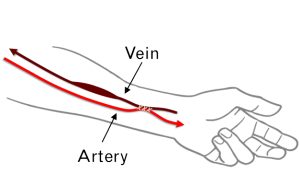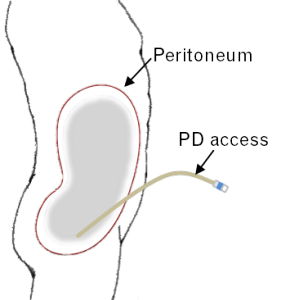
Dialysis
Dialysis does the work your kidneys can no longer do. Find out how dialysis works, the types of dialysis available and where you can dialyze.
What is dialysis?
Dialysis is a way to remove waste from your blood when your kidneys are unable to do so. If your chronic kidney disease progresses to Stage 5, kidney failure, only dialysis or a kidney transplant will keep you alive.
Your nephrologist will help you decide when to begin preparing for dialysis and which type of dialysis treatment is right for you.
Dialysis patient Khera Gurbir at our Renton clinic.
Types of dialysis
Hemodialysis
In hemodialysis, your blood flows from two needles connected to tubing (like IV lines), usually in your arm, to a machine that removes wastes and fluid. The clean blood is then returned to your body.

Peritoneal Dialysis
In peritoneal dialysis, a cleansing fluid goes into your abdomen through a small tube called a PD access. The fluid stays inside you for several hours, removing waste and water from the blood vessels of the peritoneum (lining of your abdomen). The fluid is then drained out and replaced with clean fluid. PD can work by gravity or with a machine.

Where can I dialyze?
There are two main options for where to dialyze — in one of our 20 dialysis clinics or, if you are able, at home.
In-Center Dialysis
We have 20 dialysis centers across the Puget Sound region. Together, our state-of-the-art equipment and highly trained staff ensure you get the best treatment possible. Added amenities, including TVs, laptops and Internet access, help make your time in the dialysis chair more comfortable.
Home Dialysis
Since 1964, thousands of our patients have dialyzed safely and successfully at home, using either peritoneal dialysis or hemodialysis. Home dialysis offers you greater flexibility and independence. Better still, you can get more treatment in a week, which helps you feel better.
Frequently asked questions
Good lifestyle choices will help you feel better on dialysis. Eat healthy and exercise at whatever level your doctor recommends.
Hemodialysis
If you and your doctor decide on hemodialysis, take particular care with your arms. You will need to get a hemodialysis access (likely a fistula or graft) and this will be placed in your non-dominant arm. Avoid blood pressure checks, blood draws or other needle-sticks in this arm.
Peritoneal dialysis (PD)
If you and your doctor decide on peritoneal dialysis (PD), you’ll have surgery to implant a PD access (a thin, soft tube) near your belly button. The PD access will carry dialysis fluid into your abdomen for treatment. Keep the PD access site clean and dry.
The length of your dialysis treatment is prescribed by your doctor.
Hemodialysis
Hemodialysis treatments done at a center are usually three times a week, for about four hours each treatment. People who do hemodialysis at home usually dialyze five or six times a week, for three and a half hours each treatment if they dialyze during the day or six to eight hours each treatment if they dialyze at night while they sleep.
Peritoneal dialysis (PD)
The length of your peritoneal dialysis treatments depends on the type of PD you do. People who do continuous ambulatory peritoneal dialysis (CAPD) usually do four treatments — called exchanges — by hand every day. Each exchange takes about 40 minutes. People who do automated peritoneal dialysis (APD) use a small machine called a cycler that does three exchanges for you while you sleep. Most people on APD also do one 40-minute exchange by hand during the day.
- ID and personal items – Remember to bring picture ID for your first treatment. Also, if you wear glasses or use hearing aids, remember to bring those with you.
- Comfortable clothing – The clothes you wear need to make it easy for nursing staff to get to your access. If your access is in your chest, clothing must open in the front for staff to access. What you wear should be washable and loose. Short sleeves are best for staff to take your blood pressure. Many people feel cool while on dialysis so you may want to bring a washable blanket.
- Medicine – Bring your medication lists and all of your medication bottles with you to your first appointment. A nurse will review the medications with you, make a list for your dialysis unit and will review the list with you each month for any changes.
- Food – It’s usually OK to have a light snack during your treatment. Check first with the staff in your dialysis unit if you want to have something more.
- Activities – Pass the time watching TV, reading or sleeping. We also have laptops available for you to use. You’re welcome to bring your own iPod, tablet or other device (we have free Wi-Fi). Please bring headphones to use with your device.
Hemodialysis at a center
Most patients feel tired for a few hours after hemodialysis. Notify the dialysis unit if you experiences dizziness, light-headedness or low blood pressure.
Peritoneal (PD) or Home Hemodialysis
You may feel tired at the end of a training day as you are learning about how to manage your care at home. Once you are at home doing dialysis, most PD and home hemodialysis patients report they do not feel tired after treatments.
If you drive before starting dialysis, then you can continue to do so once you have started treatment. When you first start dialysis, you may feel weak or a little unsteady after treatment. It is best to have someone pick you up after dialysis for the first week. After that, you may resume driving as you feel able. Speak to your social worker if you need help getting a ride to or from dialysis or have other transportation questions or concerns.
Depending on the type of work you do and the type of dialysis you choose, you may need to take some time off work or reshuffle your routine when you first start dialysis. Northwest Kidney Centers will work with you to find a schedule that allows you to continue to work. Speak to your social worker or doctor about what treatment might best suit your employment needs.
Prepare for dialysis
Unsure which type of dialysis is best for you? Wondering whether you should dialyze in a center or at home? Learn more at our free Choices class, designed specifically for people with Stage 3 or 4 chronic kidney disease and their families. The class covers:
- How dialysis works
- Different treatment options
- Eating well and exercising with kidney disease
Guests listen to Tom Montemayor, pharmacy manager, at a free class.